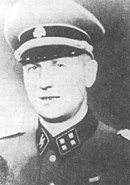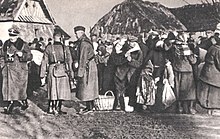Landguard Zamosc
|
SS Landwacht |
|
|---|---|
| active | December 1942 to August 1943 |
| Country |
|
| Armed forces | Order police |
| Branch of service | Auxiliary police |
| Type | battalion |
| Strength | 500 |
| Location | Labunie at Zamosc |
| Butcher | Aktion Zamosc , Aktion Werwolf I / II |
| commander | |
| commander | SS-Stubaf. Thor Jørgensen |
At the end of 1942, the SS and Police Leader from Lublin , Odilo Globocnik , commissioned the Croatian ethnic Germans who had resettled in Litzmannstadt in November 1942 and who were to be resettled in the Zamosc region in the Generalgouvernement to set up and train an active battalion of the land guard . At the same time, storms of the land guard were set up from the ethnic Germans already resident in the Zamosc region at the main bases of the gendarmerie .
Lineup
At the end of 1942 in Litzmannstadt, all Croatian Germans fit for military service from the resettler camp of the Volksdeutsche Mittelstelle between the ages of 18 and 45, who had not yet been drafted into the Waffen-SS or Wehrmacht and who were scheduled to be resettled in the Zamosc region, were placed in the active training battalion the SS Landwacht Zamosc recruited. The ethnic German resettlers from Bosnia and Slavonia and their families were relocated from the territory of the Independent State of Croatia to Litzmannstadt in the Warthegau at the end of November 1942 due to the increasing attacks by Yugoslav partisans on the remote German settlements . According to Heinrich Himmler's plans , here in the role of Reich Commissioner for the Consolidation of German Ethnicity , they were to be relocated to the Lublin district as part of Aktion Zamość - a pilot project of the General Plan East - where they were to receive the houses of displaced Poles. The battalion was trained in the Tuschin camp near Litzmannstadt in a two-month course. The instructors of the Landwacht battalion were provided by the SS Main Office in Berlin, the SS and Police Leader in Lublin and from among the resettlers themselves. This unit, made up of ethnic German settlers, was referred to by Himmler's orders as the “Landwacht” and shortly afterwards as the “SS Landwacht”. The SS Landwacht Zamosc and the SS Landwacht Netherlands , set up by SS and Police Leader Northwest, SS-Obergruppenführer Hanns Albin Rauter , were the only landguard units of the SS .
Crew and composition

The 1st SS Land Guard Battalion Zamosc, trained in the Tuschin camp, was deployed in the General Government until August 1943 . The battalion had a crew of around 500 men and consisted exclusively of Croatian Germans , while the officer corps was composed mainly of Reich Germans. In addition, there were an additional 330 men from the general SS Landwacht Zamosc, made up of ethnic German settlers from Bessarabia , Russia and Bukovina . This unit was set up directly in the Zamosc settlement area in November 1942 and was subordinate to the gendarmerie.
commander
From 1942 to August 1943, the commanding officer of the 1st SS Landwacht Battalion Zamosc stationed in Labunie was the Danish SS Sturmbannführer Thor Jørgensen, a former captain of the Danish armed forces and a member of the Free Corps Denmark . He was trained at the SS Junker School Tölz and was in the service of the SS Wiking Division on the Eastern Front until he was transferred to the General Government . In 1944 Jørgensen left the Waffen-SS at his own request and returned to Denmark , where after the war he was sentenced to several years in prison by a Danish court for his membership in the Waffen-SS.
His involvement as the leading SS commander in the ethnic cleansing and numerous massacres of Polish civilians in the Zamosc area between 1942 and 1943, which were judged as war crimes , was never prosecuted. When asked about his role during the war during the trial, Thor Jørgensen only mentioned that in 1943 he had led a battalion of ethnic Germans from Croatia in the "gang fight" in the occupied Generalgouvernement. He died in Denmark in 1992.
Participation in the Zamosc campaign
After completion of the two-month training in the Tuschin camp of the Volksdeutsche Mittelstelle near Litzmannstadt , the 1st SS Landwacht Battalion Zamosc was relocated to its new location in Labunie in the Zamosc district in February 1943 and together with the general who was already working in the Zamosc region SS Landwacht Zamosc was used to forcefully evict the Polish population from the area. During the operation, which lasted from November 1942 to August 1943, thousands of Polish civilians were killed, expelled or deported. According to a statement by SS group leader Globicniks, the settlement of German-born settlers would never have been possible without these SS Landwacht forces. The HSSPF from Lublin, Odilo Globocnik, had intended the SS Landwacht, consisting of ethnic German settlers from Eastern and Southeastern Europe, to play a central role in the ethnic cleansing of Polish villages in the Zamosc campaign.
Participation in the Werwolf I / II campaign
On June 23, 1943, "Aktion Werwolf I" started in the Lublin area, in which the 1st SS Land Guard Battalion Zamosc was deployed. After Himmler had declared the Generalgouvernement an "area to fight against gangs" due to the numerous partisan attacks, the leadership of the anti-partisan action was transferred to the SSPF of Lublin, Odilo Globocnik. In addition to the SS police and their auxiliary police officers, around 10,000 Wehrmacht soldiers were gathered in the Lublin area. During this operation, the German troops proceeded with extreme brutality against the Polish civilian population. Numerous houses were set on fire, villages were depopulated and thousands of Poles were murdered. After a large part of the German troops had been withdrawn to suppress the ghetto uprising in Bialystok , Globocnik had to cancel the Werwolf II campaign on August 15, 1943 due to the lack of police forces and finally stop the further resettlement of ethnic German settlers in the Zamosc area.
The End
After the planned "Germanization" of the area was canceled, the 1st SS Landwacht Battalion Zamosc was disbanded in August 1943 on the orders of Odilo Globocnik and its commander, SS Sturmbannführer Thor Jørgensen, was ordered to Lublin. The men of the battalion were transferred to the general SS Landwacht Zamosc and subordinated to the various main bases of the order police.
Zamosc Self-Protection Regiment
Because of the approaching front, the partisan actions against the German occupiers and settlers in the Zamosc region increased in intensity from 1944 onwards. Globocnik's successor Jakob Sporrenberg therefore ordered the formation of the Zamosc Self-Protection Regiment in May 1944. The self-protection regiment consisted of a total of three battalions. These were formed from the 2nd Battalion of the SS Police Regiment 25, the Gendarmerie Hauptmannschaft Zamosc and the SS Landwacht Zamosc. The regiment was commanded by Major Korda of the Security Police. All ethnic German men in the Zamosc district between 16 and 60 years of age were committed to service in the new regiment in May 1944.
The crew of the self-protection regiment was 2000 men. However, there was a great shortage of equipment such as machine guns or carbines, which were stocked in 10 different types of manufacture, as well as ammunition. Usually only a maximum of 20 to 25 rounds of ammunition were available per man; some unit leaders complained to their superiors that there were no longer enough uniforms and boots for the newly recruited men. When the Red Army and Polish partisan units conquered the area in July 1944 , the SS Landwacht Zamosc was disbanded at the same time as the Zamosc Self-Protection Regiment.
War crimes
According to the historians C. Christensen, N. Poulsen and P. Scharff Smith (Waffen SS - Europe's Nazistiske soldiers, 2016) it must be assumed that SS Sturmbannführer Thor Jørgensen and his men participated in the deportations classified as war crimes and numerous massacres at the Polish civilians were involved in Aktion Zamosc and Aktion Werwolf I / II .
Thus were between December 1942 to August 1943 as part of action Zamosc sold a total of 110,000 Poles from 300 villages in the area Zamosc to as part of a " umvolkung to make" the ethnic German settlers from Eastern and Southeastern Europe Square. According to the specifications of the “ German People's List ”, some of the expellees were intended to be “re-Germanized”, while the Poles who were considered “racially inferior” were either transferred to the Reich for forced labor or to the Auschwitz or Majdanek extermination camps . Around 7,000 Poles who opposed the evacuation were shot on the spot, and thousands of evacuated children and old people froze to death or starved to death.
And also in the context of the military anti-partisan actions Aktion Werwolf I / II from June 23, 1943 to August 15, 1943, the German occupiers acted with extreme brutality against the civilian population. Numerous war crimes began, such as the arbitrary shooting of Polish civilians, the eviction and deportation of tens of thousands of Polish families from their villages, and the destruction of their homes. The aim of the German troops was to finally break the armed resistance of the Polish partisans. After the war there was no legal processing of the crimes in the context of the Zamosc and Werewolf I / II campaign .
literature
- Claus Bundgård Christensen, Niels Bo Poulsen, Peter Scharff Smith: Waffen-SS, Europe's Nazi soldiers , (page 230–231), published by Gyldendal 2016, ISBN 978-87-02-09648-4 .
- Thomas Harder: Kryssing - manden, der valgte forkert (Chapter 12, Section c), published by Lindhart og Ringhof Forlag, 2014, ISBN 978-8-71-146634-6 .
- Claus Bundgård Christensen, Niels Bo Poulsen, Peter Scharff Smith: Dagbog fra Ostfronten , (section 65), published by Lindhardt og Ringhof Forlag 2012, ISBN 978-87-11-39599-8 .
- Alan E. Steinweis , Daniel E. Rogers (Eds.): The impact of Nazism: New Perspectives on the Third Reich and Its Legacy . University of Nebraska 2003, ISBN 978-0-8032-4299-9 , pp. 170-179 Table of Contents .
- Czesław Madajczyk (ed.): Zamojszczyzna - Special Laboratory SS. Zbiór dokumentów polskich i niemieckich z okresu okupacji hitlerowskiej. Ludowa Spółdzielnia Wydawnictwo, Warsaw 1977, Volume 2 (especially pages 12 and 311). Over 400 documents on “Aktion Zamosc” in German and Polish.
- Biuletyn Głównej Komisji Badania Zbrodni Hitlerowskich Polsce, Volume 21, Wydawn. Ministerstwa Sprawiedliwości, 1970, (page 125).
- Najnowsze dzieje Polski: Materiały i studia z okresu II Wojny Światowej, volumes 8-10, Państwowe Wydwo Naukowe, 1964 (page 222).
- Generalna Gubernia w planach hitlerowskich: Czesław Madajczyk, Państwowe Wydawnictwo Naukowe, 1961 (page 203).
- Yearbook for German and Eastern European Folklore: Waxmann Verlag 2010 (pages 56–58) ISBN 978-3-8309-2501-9 .
Web links
- The staff at SSPF Lublin, 1940-43
- Special Laboratory SS
- Alfred-Franke-Gricksch Report
- Odilo Globocnik's staff 1940-43
- Campaign werewolf I / II
Individual evidence
- ↑ Czesław Madajczyk (Ed.): Zamojszczyzna - Special Laboratory SS (page 361)
- ^ Gyldendal: Den Store Danske Jørgensen, Thor
- ^ Litzmannstädter Zeitung of February 11, 1943, page 4, Farewell to the Landwacht, PDF file
- ↑ Czesław Madajczyk (Ed.): Zamojszczyzna - Special Laboratory SS (page 361)
- ^ Documents Introduced in Evidence By British and American Prosecutors. District of Columbia: GPO, 1947. pp. 745-747. Act. 4024-PS Section 9, Online
- ↑ EHRI - Archive Institute for Contemporary History, files 0 270-0 279; 3 Online
- ↑ Czesław Madajczyk (Ed.): Zamojszczyzna - SS Special Laboratory (page 311)
- ↑ Czesław Madajczyk (Ed.): Zamojszczyzna - SS Special Laboratory (page 311)
- ↑ Czesław Madajczyk (Ed.): Zamojszczyzna - SS Special Laboratory (page 317)




